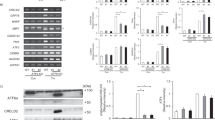Abstract
Saccharomyces cerevisiae NUD1 gene codes for a spindle pole body component and nud1 temperature-sensitive mutants arrest at 38°C in late anaphase with a tendency for lysis. We found that addition of 10% sorbitol to the medium complemented the lytic phenotype, and determination of colony-forming units evidenced the viability of nud1 cells for at least 48 hours at 38°C. The protein amount in cell-free medium increased at 38°C, and evidence is presented that intact nud1 cells exported proteins in amounts 10-fold higher compared wild type strains. The observed high amounts of extracellular acid phosphatase, invertase, and bacterial β-galactosidase suggested the export of secretory proteins. This was evidenced by construction of nudlsec mutants and the observation that interruption of the secretory pathway resulted in absence of protein export at 38°C. Proteins were exported through a cell wall showing increased porosity at 38°C. The extracellular release of Gas1p and the facilitated transformability with plasmid DNA of nud1 cells indicated alternations of their cell walls at 38°C. The export of proteins depends on oxidative phosphorylation as evidenced by disruption of the COX10 gene. Experiments with inhibitors of mitochondrial functions showed that the synthesis of adenosine triphosphate, but not the electron transport along the respiratory chain, has a key role in the export of proteins. The data show that the phenotype of S. cerevisiae nud1 mutants is characterized by enhanced export of secretory proteins and that the passage of proteins through the walls of nud1 cells is an active process.

Similar content being viewed by others
Literature Cited
Adams IR, Kilmartin JV (1999) Localization of core spindle pole (CSP) body component during duplication in Saccharomyces cerevisiae. J cell boil 145:809–823
Alexander I, Venkov P, Del Giudice A, Wolf K, Massardo DR, Del Giudice L (2001) Protein overexport in a Saccharomyces cerevisiae mutant depends on mitochondria genome integrity and function Microbiol Res 156:9–12
Alexander I, San Segundo P, Venkov P, et al. (2004) Characterization of a Saccharomyces cerevisiae thermosensitive lytic mutant leads to the identification of a new new allele of the NUD1 gene. Biochem Cell Biol 36:2196–2213
Burke D, Dawson D, Stearns T (2000) Methods in yeast genetics: gene replacement. Cold Spring Harboui, NY: Cold Spring Harbor Laboratory Press pp 59–64
Davis R (1986) Compartmental and regulatory mechanisms in the arginase pathways of N. crassaa and S. cerevisie. Microbiol Rev 50:280–313
DeNobel JG, Klis FM, Munnik T, Priem J, Vandente H (1990) An assay of relative cell-wall porositv in Saccharomyces cerevisiae, Kluyveromyces lactis and Schisosaccharomyces pombe. Yeast 6:483–490
De Nobel JG, Barnett JA (1991) Passage of molecules through yeast cell-wall: A brief assay-review. Yeast 7:313–323
DeNobel JG, Klis FM, Ram A, et al. (1991) Cyclic variation in the permeability of the cell-wall of Saccharomyces cerevisia. Yeast 7:589–598
Gaynor EC, Mondesert G, Grimme SJ (1999). MCD4 encodes a conserved endoplasmic reticulum membrane protein essential for glycosylphosphatidylinositol anchor synthesis in yeast. Mol Biol cell 10:627–648
Goldstein A, Lampen J (1975) Fructofuranoside fructohydrolase from yeast. Methods Enzym 42:504–511
Grant CM, Maclver FH, Daves IW (1997) Mitochondrial function is required for resistance to oxidative stress in the yeast Saccharomyces cerevisiae. FEBS Lett 410:219–222
Grote E, Carr CM, Novick PJ (2000) Ordering the final events in yeast exocytosis. J Cell Biol 151:439–451
Grunneberg U, Campbell K, Simpson C, et al. (2000) Nudl p links astral microtubule organization and the control of exit of mitosis. EMBO 19:6475–6488
Harlow E, Lane D (1988) Antibodies: A laboratory Manual. Cold Spring Harbor, NY: Cold Spring Harbor Laboratory Press
Hartwell L, Weinert T, Kadyk L, et al. (1994) Cell-cycle checkpoints, genomic integrity and cancer. Cold Spring Harb Symp Quant Biol 59:259–263
Horvath A, Reizman H (1994) Rapid protein extraction from Saccharomyces cerevisiae. Yeast 10:1305–1310
Hoffman R, Valencia A (2004). A gene network for navigating the literature. Nat Genet 36: 664–681
ItoH, Fukuda Y, Murata et al. (1983) Transformation of intact yeast cells treated with alkali cations. Bacteriol 153:163–168
Kalebina TS, Laurinavichiute DK, Packeiser AN (2002) Correct GPI-anchor synthesis is required for the incorporation of endoglucane/glucanosyltransferase Bgl2p into the Saccharomyces cerevisiae cell wall. FEMS Microbiol Lett 210:81–85
Klis FM (1994) Cell wall assembly in yeast. Yeast 10:851–870
Lemire JM, Willocks T, Halvarson HO, et al. (1985) Regulation of repressible acid phosphatase gene transcription in Saccharomyces cerevisiae. Mol Cell Biol 15:2131–2141
Moracci M, La Volpe A, Pulitzer J, et al. (1992) Expression of the thermostabile alactosidase from the archaebacterium Sulfolobus solfatiricus in Saccharomyces cerevisiae and characterization of a new inducible promoter for heterologous expression. J Bacteriol l74:873–882
Nobrega MP, Nobrega FG, Tzagoloff A (1990) COX 10 codes for a protein homologous to the ORF1 product of Paracoccus denitrificans and is required for the synthesis of cytochrome oxidase. J bio1 Chem 265:l4220–14226
Nurse P, Masui Y, Hertwell L (1998) Understanding the cell-cycle. Nat Med 4:1103–1106
Pisani F, Rella R, Raia G, et al. (1990) Termostabile beta-galactosidase from the archaebacterium Sulfolobus solfataricus: Purification and properties. Eur J Biochem 187:321–328
Popolo L, Vai M (1999) The Gas 1 glycoprotein, a putative wall polymer cross-linker. Biochem Biophys Acta 1426:385–440
Rasmussen AK, Chatterjee A, Rasmussen LJ, et al. (2003) Mitochondria-mediated nuclear mutator phenotype in Saccharomyces cerevisiae. Nucl Acid Res 31: 3909–3917
Schonholzer F, Schweingruber AK, Trachsel (1985) Intracellular maturation and secretion of acid phosphatase of Saccharomyces cerevisiae. Eur.J.biochem 14:273–279
Waltschewa L, Philipova D, Venkov P (1989) Increased extracellular secretion fragile mutants of Saccharomyces cerevisiae. Yeast 5:313–320
Zaworski P, Gill G (1988) Precipitation and recovery of proteins from culture supernatant using zinc. Anal Biochem 73l:440–444
Zlotnik H, Fernandez MP, Bowers B, et al. (1984) S. cerevisiae mannoproteins form an external cell-wall layer that determines wall porosity. J Bacteriol I59:1018–1026
Author information
Authors and Affiliations
Corresponding author
Rights and permissions
About this article
Cite this article
Pesheva, M.G., Koprinarova, M.K. & Venkov, P. Enhanced Protein Export in Saccharomyces cerevisiae nud1 Mutants Is an Active Process. Curr Microbiol 53, 496–501 (2006). https://doi.org/10.1007/s00284-006-0210-7
Received:
Accepted:
Published:
Issue Date:
DOI: https://doi.org/10.1007/s00284-006-0210-7




